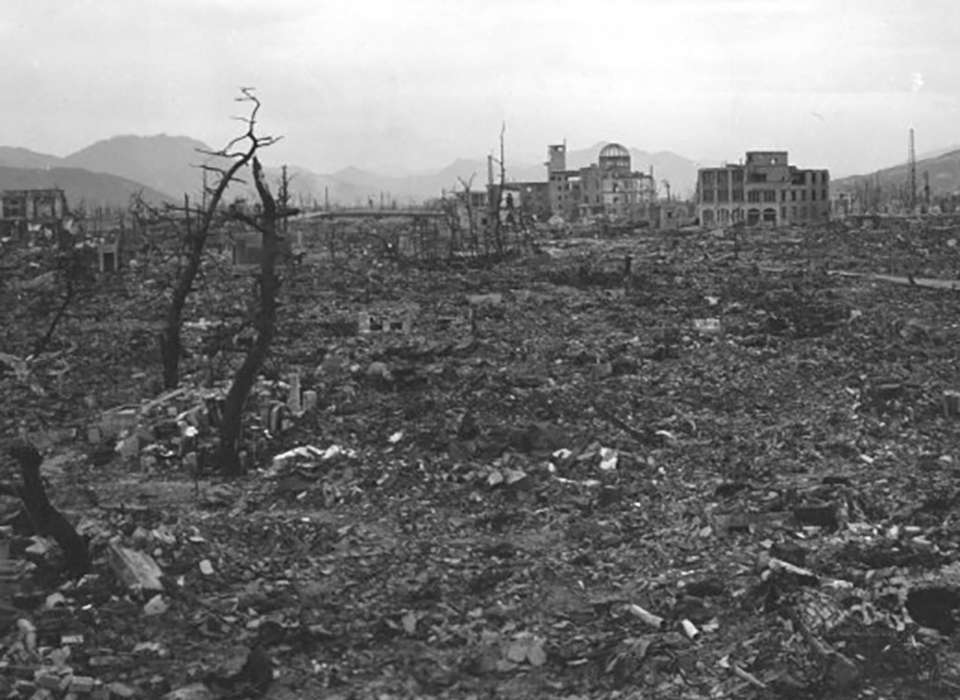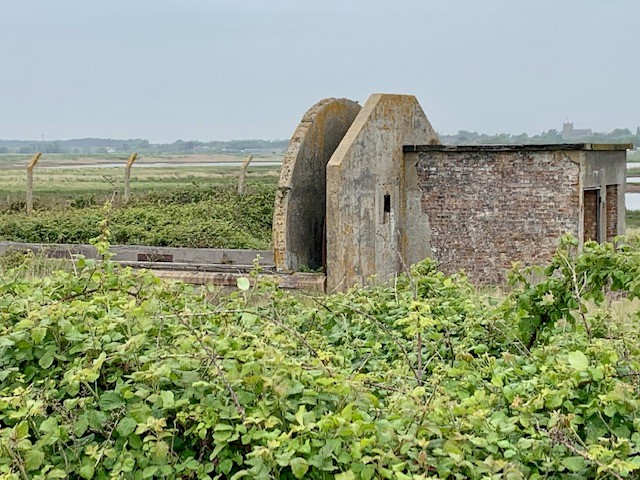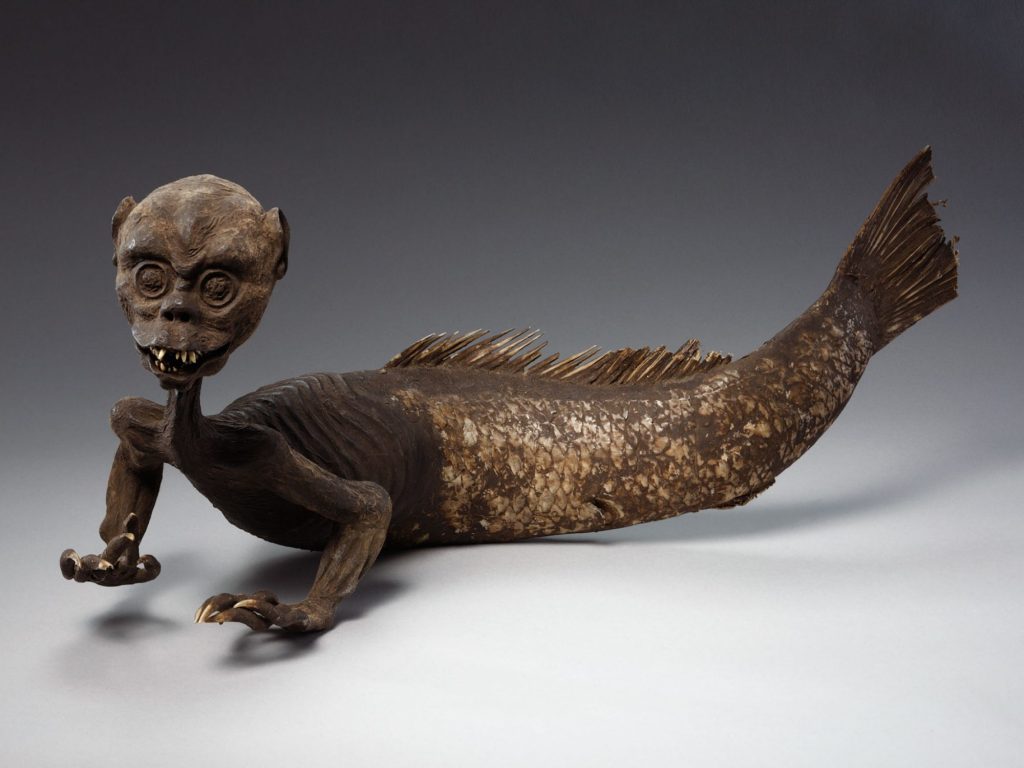A Mythological Merman and Legends of the Cold War: Stories of Orford Ness

As she was carried through the streets of the city, Miss Sasaki noticed something ‘that particularly gave her the creeps. Over everything – up through the wreckage of the city, in gutters, along the riverbanks, tangled among tiles and tin roofing, climbing on charred tree trunks – was a blanket of fresh, vivid, lush, optimistic green.’ The city was Hiroshima, the date September 9th 1945, thirty-four days after the dropping of the atomic bomb, and Miss Sasaki was being carried to the Red Cross hospital where it was hoped a persistent wound in her leg could be treated. Already ‘wild flowers were in bloom among the city’s bones.’

This image, recounted by the American writer, John Hersey, in his essay, Hiroshima, resonated with me the first time I visited Orford Ness, an elbow-shaped spit of land in the North Sea, off the coast of Suffolk, which plies its wayward path from Aldeburgh at its northern end to a point just south of Orford where it tails off into Hollesley Bay.
I am not being precise about the distance between Orford and the southern end of the Ness because it keeps changing. The Ness is currently between nine and twelve miles long, depending on what authority you consult. North Weir Point, at the southernmost tip of the peninsula (even the topographical nomenclature is at best contradictory, at worst downright deceitful) was about two and a half miles further north in 1588 than it is now; in 1893 it was a mile or so south of where it is today. (Well, the map I consulted was last updated in 2022 and there has been a bit of weather since then, so that estimation might already be out of date.) The elbow joint was a good deal more pronounced and arthritically swollen in 1601 than on my 2022 map. As Robert Macfarlane was once enjoined by an Orford local, ‘The first rule of Orford Ness is, never believe anything you’re told about it.’
For seventy years, from 1913 to 1983, this ‘untrue island’ (Macfarlane 2012) belonged to the Ministry of Defence, which used it to construct secret weapons tests and to listen in to our enemies, eerie, encoded whisperings through forests of radio masts. An Anglo-American collaboration on experimental over-the-horizon radar, codenamed Cobra Mist, was carried out there. The architecture of these activities, from targets for air gunnery to monitoring stations for aircraft practising precision bombing off this notably imprecise border between land and sea, to the stress testing of components for nuclear missiles, remains, even though the Ness itself is now a nature reserve in the care of the National Trust. The Trust maintains a few of the buildings to house a museum, activity centre and a bunkhouse for overnight ‘dawn chorus’ visits. Many of the rest, however, have fallen into decay and, like the ruins of Hiroshima, are festooned with greenery – ivy, bindweed, Russian vine.

In another uncanny parallel, one of those inexplicable connections which might be coincidence or might be the thinning of the veil between layers of the multiverse Orford Ness’s most iconic ruins are those known as the pagodas because of their distinctive roof-shape, their upturned eaves reminiscent of those of the temple pagodas found all over East Asia, including, of course, Japan. These were built for the purpose of carrying out environmental tests on atomic bombs; the pagoda roofs were designed to absorb and contain the various shocks that might disable a bomb before detonation. Bomb shelters for atomic bombs. Today they are romantic ghosts, adrift with sand and the songs of the wind, themselves in need of protection from too much imagining.
Legend has its part to play too in the ambiguous, shape-shifting magic of Orford. The historian Ralph of Coggeshall records in 1207 that during the reign of Henry II, ‘some fishermen who were fishing in the sea caught a wild man in their nets.’ This wild man, the Orford Merman, was brought ashore and kept captive in Orford Castle where the castellan, Bartholomew de Glanville, attempted to question him. To no avail. As Andrew Motion puts it in his poem, Salt Water, the merman ‘cried out what sounded like his soul/but never cried a word.’ Language failed him in the face of the trauma of being suddenly lifted out of his accustomed element, thrown into the castle dungeon and, Ralph tells us, ‘suspended by his feet and tortured.’ Eventually the villagers lost interest in him and returned him to sea, but here begins the most mysterious, untold part of his story.

Rather than fleeing the village and its terrible associations, the merman came back ashore and was never seen again, although he has survived in bland and innocuous form as a restaurant sign and a hassock in the village church. His ‘true’ fate is a cliff-hanger if ever there was one, though there are no cliffs at Orford, just sand, shingle, rip-rap and marram grass. This darkness, of the traumatised merman, so othered by his experience at human hands he could never return home, seems to invest the later history of the area with an emotional truth which the mathematical calculations of missile trajectories and blast impacts work to disguise. His wordless voice is there, perhaps a kind of atmospheric interference in the enemy chatter intercepted by the radio listening station.
I have always felt drawn to the weird and the sinister that underlies and throws into relief the restorative beauties of the English countryside. From Midsomer Murders to Stranger Things, Dickens’ Romney Marshes to Dracula’s Carpathia to Red Riding Hood’s forest, even though more than half of us today live in cities, our stories remind us that nature is out there, seductive and ruthless, just waiting for us to put a foot wrong. From my very first visit to Orford, now well over thirty years ago, something about the place snagged on my imagination and would not let go. It would be easy to attribute this to the stark ruins of the castle where the merman was imprisoned or the ghostly silhouettes of the pagodas glimpsed through sea frets. But it is not so much the confluence of these things as the why of it. Why did the merman swim into humankind’s net off this particular stretch of coast? Why did the MoD choose Orford Ness to test to destruction, to shroud in Cobra Mist? Of course, there are rational answers to each of these questions, even, possibly, that of the merman, but when you put them all together you are compelled to wonder if there is something else going on, something beyond reason that we feel in the pricking of our thumbs.
I knew I wanted to write about Orford, and it seemed yet another strange coincidence of fate that, some ten years after my first visit, my MA tutor should be Andrew Motion, whose poem Salt Water I quoted earlier. Another writer entranced by the bleak magic of this shifting shore and its histories, as is M. R. James, whose ghostly tale, A Warning to the Curious, begins with an account of ‘marshes intersected by dykes, recalling the early chapters of Great Expectations.’ Orford went on my list. One day I would set about some systematic research and construct a novel. One day.
In 2020 I embarked on a creative and critical writing PhD. For that I am writing a two-period historical novel set largely in France and America and not at all on the east coast of England. At the end of my first year, with the summer in front of me in which to write and continuing Covid restrictions to minimise any distraction, I sat down at my computer, opened up the file…

…drew a notebook towards me and found myself writing something completely different. Over the course of that summer, while my left brain, if you will, worked on my PhD, my right brain wrote what eventually became my soon to be published novella, Lines and Shadows. It scribbled away in the notebook, without a plan or even the sketchiest map to guide it, in odd fragments of time while the kettle was boiling or I waited in a phone queue or watched TV with half my attention. By the end of that year it had produced around 30,000 words about maths and mythology, spies, the Cuban Missile Crisis and postpartum psychosis. To this day I really have no idea where it came from, except that its setting, although fictional, was clearly also Orford. An Orford through the looking glass. Orford had no intention of shuffling patiently up my list. Instead, it lurked, it prowled, it awaited its moment to pounce and ambushed me.
I have since often wondered why this happened and how Lines and Shadows came to me in the way it did, and it seems to me it was speaking all along to themes which are also present in my PhD work. That novel, Daughters of Heaven, concerns pioneering balloon flight in the 1780s and the Apollo space missions of the late 1960s. It is partly narrated by the Moon and perhaps one thing it is about is our questing human inability to live quietly within the eco-system which brought us into being. We have a good idea where our hubristic curiosity is taking us now and it probably isn’t Mars. Perhaps our sense of the rural uncanny today has as much to do with our fear of the future as with the atavistic terrors of our souls. We look at nature and we see, as Miss Sasaki did in 1945, what will flourish when we are gone.
References
Hersey J. (1986 [1946]), Hiroshima, Penguin Modern Classics, London
James M. R., (1931), ‘A Warning to the Curious’ in The Collected Ghost Stories, Edward Arnold & Co., London
Macfarlane R. (2012) ‘Untrue Island: the Voices of Orford Ness’, The Guardian, 8th July 2012 https://www.theguardian.com/culture/2012/jul/08/untrue-island-orford-ness-macfarlane accessed online various dates
Macfarlane R., Donwood S. and Richards, D. (2020), Ghostways, W. W. Norton, New York
Motion A. (1998), Selected Poems 1976 – 1997, Faber and Faber, London
Ralph of Coggeshall, quoted at [1] https://bitaboutbritain.com/orford-castle-and-a-merman/ accessed 04/04/20
Bibliography
Carroll L. (1982 [1872]), Through the Looking Glass in Complete Illustrated Works of Lewis Carroll, Chancellor Press, London
Dickens C. (1867 [1861]), Great Expectations, accessed online 05/04/2023 via Project Gutenberg https://www.gutenberg.org/cache/epub/1400/pg1400-images.html
Shakespeare W. (1623) The Tragedie of Macbeth, accessed via Folger Shakespeare Library https://www.folger.edu/explore/shakespeares-works/macbeth/read/ 05/04/2023
Stoker B. (2008 [1897]), ed. Klinger L. S., The New Annotated Dracula, W. W. Norton, New York
TV Series
Midsomer Murders (1997 – 2022), ITV
Stranger Things (2016 – 2022), Netflix